
|
Now it is bright as 10.5 mag (Feb. 6, Marco Goiato). In the Northern Hemisphere, it stays observable in excellent condition after this. In the Southern Heimsphere, it will be getting lower rapidly after this, and it will be unobservable in mid March.
Date(TT) R.A. (2000) Decl. Delta r Elong. m1 Best Time(A, h)
Feb. 13 6 21.41 14 43.0 0.595 1.446 130 11.0 20:45 (180, 39)
Feb. 20 5 49.51 26 46.8 0.735 1.471 116 11.5 20:17 (172, 27)
|
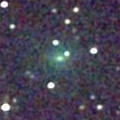
|
Brightened rapidly. Now it is very bright as 12.6 mag (Dec. 25, Ken-ichi Kadota). It will approach to Earth down to 0.46 a.u. in April, and it is expected to brighten up to 9 mag and to be observable in excellent condition. It becomes unobservable temporarily from January to February.
Date(TT) R.A. (2000) Decl. Delta r Elong. m1 Best Time(A, h)
Feb. 13 20 51.35 -14 5.3 2.004 1.067 13 11.3 3:59 (293, -8)
Feb. 20 20 46.76 -13 6.4 1.900 1.042 21 11.1 4:08 (286, 0)
|

|
Now it is bright as 12.9 mag (Feb. 9, Chris Wyatt). It stays 12 mag until March. In the Southern Hemisphere, it stays observable in good condition after this. In the Northern Hemisphere, it will never be observable after this.
Date(TT) R.A. (2000) Decl. Delta r Elong. m1 Best Time(A, h)
Feb. 13 15 37.93 -77 56.3 1.916 1.953 77 11.9 3:59 (351, 45)
Feb. 20 16 13.03 -83 41.7 1.933 1.997 79 12.0 4:08 (356, 40)
|
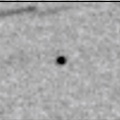
|
It will brighten up to 11.5 mag in spring. However, the condition is very bad in this apparition. It will appear in the morning low sky in March in the Southern Hemisphere, or in June in the Northern Hemisphere.
Date(TT) R.A. (2000) Decl. Delta r Elong. m1 Best Time(A, h)
Feb. 13 20 11.63 -18 20.9 2.327 1.472 23 12.3 3:59 (291, 3)
Feb. 20 20 35.69 -17 36.6 2.294 1.453 24 12.1 4:08 (288, 5)
|

|
It brightened up to 5.6 mag in early December (Dec. 9, Marco Goiato). In mid December, it was visible at about 3 mag in the SOHO spacecraft images (Dec. 18, Hirohisa Sato). Now it is not observable. It will appear in the morning sky again in April. But then it will be fainter than 15 mag.
Date(TT) R.A. (2000) Decl. Delta r Elong. m1 Best Time(A, h)
Feb. 13 21 44.28 -1 37.5 2.386 1.434 11 12.5 3:59 (292,-26)
Feb. 20 22 1.35 0 6.7 2.509 1.553 11 12.9 4:08 (287,-23)
|
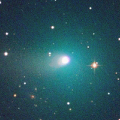
|
Brightened rapidly, and it brightened up to 9.7 mag in November (Nov. 15, Chris Wyatt). Now it is fading. But it is bright as 12.0 mag still now (Feb. 9, Chris Wyatt). In the Northern Hemisphere, it stays observable in good condition for a long time. In the Southern Hemisphere, it locates extremely low after this.
Date(TT) R.A. (2000) Decl. Delta r Elong. m1 Best Time(A, h)
Feb. 13 3 18.26 38 41.7 1.278 1.656 93 12.7 20:27 (149, 7)
Feb. 20 3 40.32 39 35.5 1.371 1.701 90 13.0 20:17 (151, 7)
|
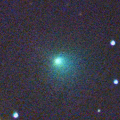
|
New periodic comet discovered in 2016. It had been predicted to return in 2024. But actually, it returned much earlier than predicted. It brightened up to 11 mag in January (Jan. 16, Giuseppe Pappa). Now it is fading. In the Southern Hemisphere, it stays observable in excellent condition after this. In the Northern Hemisphere, it will never be observable after this.
Date(TT) R.A. (2000) Decl. Delta r Elong. m1 Best Time(A, h)
Feb. 13 20 37.83 -48 34.2 0.534 0.654 37 13.0 3:59 (319, 16)
Feb. 20 20 3.03 -51 23.8 0.576 0.742 48 14.6 4:08 (315, 27)
|
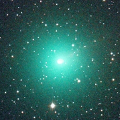
|
It brightened up to 7.3 mag in November (Nov. 7, Marco Goiato). Now it is fading. It has already faded down to 14.0 mag (Feb. 7, Toshihiko Ikemura, Hirohisa Sato). In the Northern Hemisphere, it stays observable in excellent condition for a long time. In the Southern Hemisphere, it stays locating extremely low after this.
Date(TT) R.A. (2000) Decl. Delta r Elong. m1 Best Time(A, h)
Feb. 13 5 49.38 48 28.6 1.324 2.011 120 13.1 20:27 (178, 7)
Feb. 20 5 59.73 48 8.1 1.452 2.082 115 13.6 20:17 (177, 7)
|
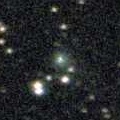
|
Now it is 12.4 mag (Feb. 8, Toshihiko Ikemura, Hirohisa Sato). It will brighten up to 10 mag in winter in 2022. In the Northern Hemisphere, it stays observable in good condition for a long time. In the Southern Hemisphere, it is not observable until November.
Date(TT) R.A. (2000) Decl. Delta r Elong. m1 Best Time(A, h)
Feb. 13 1 2.19 52 53.4 4.709 4.615 78 13.2 20:27 (142,-19)
Feb. 20 1 12.66 52 28.4 4.747 4.577 74 13.1 20:17 (141,-20)
|
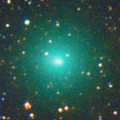
|
It brightened up to 8.2 mag in autumn (Oct. 13, Chris Wyatt). Now it is fading. It has already faded down to 13.0 mag (Feb. 14, Sandor Szabo). In the Southern Hemisphere, it is already unobservable. In the Northern Hemisphere, it will be unobservable in late February.
Date(TT) R.A. (2000) Decl. Delta r Elong. m1 Best Time(A, h)
Feb. 13 23 59.01 -2 24.8 2.705 1.974 34 13.3 20:27 ( 88, 1)
Feb. 20 0 13.97 -0 39.3 2.794 2.021 31 13.5 20:17 ( 89, -1)
|
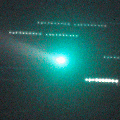
|
It brightened very rapidly in early December, and it brightened up to 10.0 mag in January (Jan. 7, Michael Jager). Now it is fading. It has already faded down to 13.3 mag (Feb. 9, Chris Wyatt). Two more components, H and I, are also observed. It stays observable for a long time in this apparition.
Date(TT) R.A. (2000) Decl. Delta r Elong. m1 Best Time(A, h)
Feb. 13 3 55.81 -0 5.8 0.669 1.215 92 13.3 20:27 (134, 45)
Feb. 20 4 32.02 1 20.2 0.747 1.289 94 14.2 20:17 (140, 46)
|
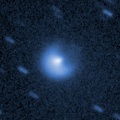
|
Now it is 13.9 mag (Feb. 9, Toshihiko Ikemura, Hirohisa Sato). In the Southern Hemisphere, it will be unobservable in late February.
Date(TT) R.A. (2000) Decl. Delta r Elong. m1 Best Time(A, h)
Feb. 13 2 24.66 23 54.8 5.989 5.857 77 13.6 20:27 (131, 12)
Feb. 20 2 28.12 23 59.9 6.099 5.859 71 13.7 20:17 (129, 10)
|
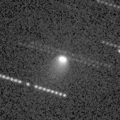
|
Brightening very rapidly. Now it is very bright as 12.5 mag (Feb. 8, Michael Jager). Now it is approaching to Earth down to 0.4 a.u. In the Northern Hemisphere, it stays observable in excellent condition. It will be observable in good condition after this also in the Southern Hemisphere.
Date(TT) R.A. (2000) Decl. Delta r Elong. m1 Best Time(A, h)
Feb. 13 6 27.32 58 30.2 0.435 1.271 121 13.8 20:44 (180, -2)
Feb. 20 5 5.11 35 48.5 0.496 1.228 106 13.7 20:17 (163, 18)
|
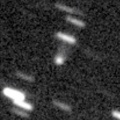
|
It will brighten up to 13 mag from spring to summer. In the Southern Hemisphere, it stays observable in good condition for a long time. In the Northern Hemisphere, it is not observable until July in 2022.
Date(TT) R.A. (2000) Decl. Delta r Elong. m1 Best Time(A, h)
Feb. 13 17 32.14 -55 27.5 4.110 3.783 64 13.8 3:59 (316, 45)
Feb. 20 17 45.19 -57 1.5 4.015 3.764 68 13.8 4:08 (319, 48)
|
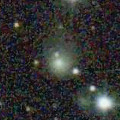
|
Now it is 14.2 mag (Feb. 8, Toshihiko Ikemura, Hirohisa Sato). It is expected to be observable at 5-6 mag for a long time from 2022 to 2023. In the Northern Hemisphere, it is not observable at the high light from 2022 summer to 2023 summer. In the Southern Hemisphere, it is not observable now. But it will be observable in good condition at the high light.
Date(TT) R.A. (2000) Decl. Delta r Elong. m1 Best Time(A, h)
Feb. 13 18 16.59 35 53.6 7.381 7.102 69 13.9 3:59 (231, -7)
Feb. 20 18 19.59 36 16.5 7.281 7.046 72 13.8 4:08 (226, -2)
|

|
First return of a new periodic comet which brightened up to 13 mag in 2009. It brightened up to 11.7 mag in January (Jan. 10, Marco Goiato). Now it is fading. It has already faded down to 13.7 mag (Feb. 7, Toshihiko Ikemura, Hirohisa Sato). It stays observable in good condition while the comet will be fading after this.
Date(TT) R.A. (2000) Decl. Delta r Elong. m1 Best Time(A, h)
Feb. 13 6 10.80 22 33.7 0.573 1.416 128 13.8 20:38 (180, 32)
Feb. 20 6 28.71 24 36.3 0.631 1.447 125 14.2 20:28 (180, 30)
|
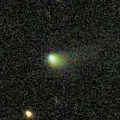
|
Now it is 15.5 mag (Jan. 19, Slooh.com Chile Observatory, La Dehesa). It stays 13-14 mag from 2020 to 2021. It will be observable in good condition after this in the Southern Hemisphere. It locates somewhat low in the Northern Hemisphere.
Date(TT) R.A. (2000) Decl. Delta r Elong. m1 Best Time(A, h)
Feb. 13 17 57.32 -22 1.2 3.317 2.864 54 14.1 3:59 (276, 31)
Feb. 20 18 8.02 -22 22.0 3.237 2.864 59 14.1 4:08 (273, 37)
|
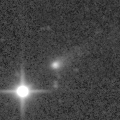
|
Now it is 14.2 mag (Feb. 9, Toshihiko Ikemura, Hirohisa Sato). It is expected to brighten up to 12.5 mag from spring to summer, and it stays observable in good condition for a long time.
Date(TT) R.A. (2000) Decl. Delta r Elong. m1 Best Time(A, h)
Feb. 13 13 55.82 28 58.8 2.045 2.684 120 14.6 3:59 (186, 26)
Feb. 20 14 0.49 29 52.2 1.949 2.634 124 14.4 4:01 (180, 25)
|
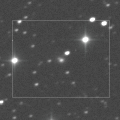
|
Now it is 14.4 mag (Jan. 20, iTelescope Observatory, Siding Spring). It will brighten up to 13.5 mag in spring. In the Southern Hemisphere, it stays observable in good condition for a long time. In the Northern Hemisphere, it will be getting higher and becoming observable slowly.
Date(TT) R.A. (2000) Decl. Delta r Elong. m1 Best Time(A, h)
Feb. 13 17 51.33 -40 32.0 3.834 3.409 57 14.7 3:59 (297, 39)
Feb. 20 17 50.34 -40 18.9 3.706 3.398 64 14.7 4:08 (294, 46)
|

|
Now it is 14.2 mag and visible visually (Jan. 25, Chris Wyatt). It is expected to brighten up to 11.5 mag in 2022. It is observable in excellent condition in the Southern Hemisphere. In the Northern Hemisphere, it is observable from autumn to winter, but it locating extremely low.
Date(TT) R.A. (2000) Decl. Delta r Elong. m1 Best Time(A, h)
Feb. 13 8 7.11 -39 36.1 5.170 5.756 122 14.8 22:32 ( 0, 85)
Feb. 20 8 4.38 -38 59.0 5.139 5.720 121 14.7 22:02 ( 0, 86)
|

|
It had been observed as 8-9 mag for a long time in 2020. Now it is fading. It has already faded down to 16.6 mag (Jan. 23, Slooh.com Chile Observatory, La Dehesa). It will be observable in good condition after this in the Southern Hemisphere. It locates extremely low after this in the Northern Hemisphere.
Date(TT) R.A. (2000) Decl. Delta r Elong. m1 Best Time(A, h)
Feb. 13 17 31.71 -32 4.2 4.177 3.792 60 14.9 3:59 (285, 40)
Feb. 20 17 36.28 -33 0.3 4.141 3.858 66 15.0 4:08 (283, 47)
|

|
Now it is 15.8 mag (Jan. 16, Slooh.com Canary Islands Observatory). It is not observable until June.
Date(TT) R.A. (2000) Decl. Delta r Elong. m1 Best Time(A, h)
Feb. 13 22 38.49 -3 24.6 3.010 2.081 16 15.0 20:27 ( 75,-15)
Feb. 20 22 52.56 -1 23.6 3.028 2.081 13 15.0 20:17 ( 76,-17)
|
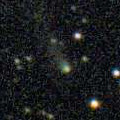
|
Now it is 15.9 mag (Nov. 10, Toshihiko Ikemura, Hirohisa Sato). It will stay at 14 mag for a long time from 2021 to 2022. In the Northern Hemisphere, it stays observable in good condition while brightening gradually. In the Southern Hemisphere, it will appear in the morning sky soon. Then it will be observable in good condition.
Date(TT) R.A. (2000) Decl. Delta r Elong. m1 Best Time(A, h)
Feb. 13 18 18.63 2 56.7 5.904 5.383 53 15.1 3:59 (257, 13)
Feb. 20 18 20.55 2 44.3 5.798 5.364 59 15.1 4:08 (252, 20)
|
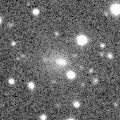
|
Brightened very rapidly. Now it is 15.0 mag (Feb. 4, Michael Jager). It stays observable at 15-16 mag in good condition for a while. It locates low in the Southern Hemisphere.
Date(TT) R.A. (2000) Decl. Delta r Elong. m1 Best Time(A, h)
Feb. 13 3 42.46 27 27.6 1.535 1.901 95 15.2 20:27 (148, 19)
Feb. 20 3 57.23 27 42.9 1.614 1.917 91 15.1 20:17 (147, 19)
|

|
Now it is 15.8 mag (Jan. 14, Slooh.com Chile Observatory, La Dehesa). It stays 14-15 mag until the end of 2021. In the Southern Hemisphere, it stays observable in good condition for a long time, although it becomes extremely low temporarily from January to February. In the Northern Hemisphere, it is not observable until June.
Date(TT) R.A. (2000) Decl. Delta r Elong. m1 Best Time(A, h)
Feb. 13 21 53.40 -48 15.9 5.112 4.338 34 15.2 20:27 ( 35, 8)
Feb. 20 22 3.51 -47 3.7 5.094 4.334 36 15.2 4:08 (323, 9)
|
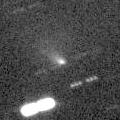
|
Now it is 16.0 mag (Feb. 8, Michael Jager). It stays 15-16 mag until spring. In the Northern Hemisphere, it stays observable in excellent condition. In the Southern Hemisphere, it stays extremely low until spring.
Date(TT) R.A. (2000) Decl. Delta r Elong. m1 Best Time(A, h)
Feb. 13 2 17.80 23 58.5 1.231 1.382 76 15.3 20:27 (130, 11)
Feb. 20 2 42.97 22 18.7 1.239 1.355 73 15.4 20:17 (130, 13)
|

|
First return of a new periodic comet which brightened up to 14-15 mag in 2006. Now it is 15.5 mag (Feb. 8, Toshihiko Ikemura, Hirohisa Sato). It will brighten up to 15-16 mag from February to March, and will be observable in good condition.
Date(TT) R.A. (2000) Decl. Delta r Elong. m1 Best Time(A, h)
Feb. 13 13 0.01 7 35.0 0.942 1.763 132 15.5 3:28 (180, 48)
Feb. 20 13 7.55 9 29.4 0.914 1.772 137 15.4 3:08 (180, 46)
|
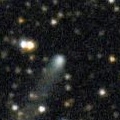
|
Now it is 15.5 mag (Feb. 9, Toshihiko Ikemura, Hirohisa Sato). It stays 15-16 mag until spring. In the Northern Hemisphere, it stays observable in good condition for a long time. In the Southern Hemisphere, it will be observable in the extremely low sky only in next spring.
Date(TT) R.A. (2000) Decl. Delta r Elong. m1 Best Time(A, h)
Feb. 13 19 13.35 28 43.6 5.362 4.879 56 15.5 3:59 (244,-13)
Feb. 20 19 16.06 30 10.5 5.333 4.902 59 15.5 4:08 (238, -7)
|

|
Now it is 16.3 mag (Nov. 9, Toshihiko Ikemura, Hirohisa Sato). It will brighten up to 14.5 mag from spring to summer. In the Southern Hemisphere, it stays observable in excellent condition for a long time, although it becomes extremely low temporarily from January to February. In the Northern Hemisphere, it is not observable after this.
Date(TT) R.A. (2000) Decl. Delta r Elong. m1 Best Time(A, h)
Feb. 13 22 15.07 -38 35.7 3.596 2.742 25 15.6 20:27 ( 45, 4)
Feb. 20 22 24.08 -39 26.4 3.551 2.724 28 15.5 20:17 ( 43, 3)
|

|
Now it is not observable. It will be observable in June. But it will fade down to 17 mag at that time.
Date(TT) R.A. (2000) Decl. Delta r Elong. m1 Best Time(A, h)
Feb. 13 21 34.44 -19 6.2 2.589 1.611 6 15.7 3:59 (304,-12)
Feb. 20 21 55.11 -16 43.0 2.572 1.596 7 15.7 4:08 (299,-11)
|

|
Now it is 14.9 mag (Feb. 9, Toshihiko Ikemura, Hirohisa Sato). In the Northern Hemisphere, it stays observable for a long time while it is getting fainter slowly. In the Southern Hemisphere, it will never be observable again.
Date(TT) R.A. (2000) Decl. Delta r Elong. m1 Best Time(A, h)
Feb. 13 16 37.94 63 56.4 5.050 5.254 96 15.8 3:59 (199,-15)
Feb. 20 16 35.96 64 49.8 5.080 5.302 97 15.8 4:08 (195,-14)
|
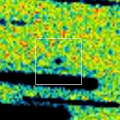
|
It will brighten up to 13 mag from spring to summer. In the Southern Hemisphere, it stays observable in good condition for a long time. In the Northern Hemisphere, it locates extremely low now, and it will be unobservable soon. Then it is not observable until September when it fades down to 15 mag.
Date(TT) R.A. (2000) Decl. Delta r Elong. m1 Best Time(A, h)
Feb. 13 19 6.52 -25 56.7 2.825 2.155 39 16.1 3:59 (289, 19)
Feb. 20 19 21.57 -27 30.1 2.697 2.093 43 15.9 4:08 (288, 24)
|
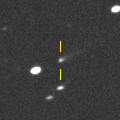
|
Now it is 15.5 mag (Feb. 9, Toshihiko Ikemura, Hirohisa Sato). It will brighten up to 13 mag in 2022. In 2021, it is observable at 15-16 mag in good condition.
Date(TT) R.A. (2000) Decl. Delta r Elong. m1 Best Time(A, h)
Feb. 13 13 45.30 -2 53.3 3.243 3.813 118 16.0 3:59 (187, 58)
Feb. 20 13 45.40 -2 47.4 3.138 3.798 125 15.9 3:46 (180, 58)
|

|
Now it is 16.5 mag (Feb. 5, Thomas Lehmann). It brightens up to 15 mag from spring to summer. In the Southern Hemisphere, it stays observable in good condition until June. In the Northern Hemisphere, it is observable in the low sky from March to May.
Date(TT) R.A. (2000) Decl. Delta r Elong. m1 Best Time(A, h)
Feb. 13 5 55.03 -58 18.1 2.412 2.674 94 16.2 20:27 ( 3, 67)
Feb. 20 5 54.40 -55 18.3 2.348 2.621 94 16.0 20:17 ( 10, 69)
|
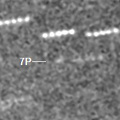
|
Now it is 18.1 mag, much fainter than predicted (Feb. 8, Toshihiko Ikemura, Hirohisa Sato). It will brighten up to 11 mag from May to August. In the Southern Hemisphere, it stays observable in excellent condition for a long time. In the Northern Hemisphere, it stays observable in good condition for a while. But it becomes extremely low after July.
Date(TT) R.A. (2000) Decl. Delta r Elong. m1 Best Time(A, h)
Feb. 13 15 40.97 9 51.8 1.357 1.726 93 16.4 3:59 (221, 36)
Feb. 20 15 58.72 9 48.3 1.262 1.675 95 16.1 4:08 (216, 38)
|

|
Now it is 16.5 mag (Feb. 9, Toshihiko Ikemura, Hirohisa Sato). It is observable at 16 mag from 2020 to 2021. In the Southern Hemisphere, it is not observable until summer.
Date(TT) R.A. (2000) Decl. Delta r Elong. m1 Best Time(A, h)
Feb. 13 22 38.13 44 10.9 6.398 5.948 58 16.4 20:27 (122,-38)
Feb. 20 22 42.46 43 40.4 6.457 5.947 55 16.4 20:17 (121,-40)
|
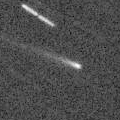
|
It brightened very rapidly up to 16.5 mag in January (Jan. 2, D. Buczynski). However, it is fading very rapidly in February. It has already faded down to 18.3 mag (Feb. 11, Toshihiko Ikemura, Hirohisa Sato). It is observable in excellent condition in the Northern Hemisphere. It locates somewhat low in the Southern Hemisphere.
Date(TT) R.A. (2000) Decl. Delta r Elong. m1 Best Time(A, h)
Feb. 13 2 50.59 18 31.9 1.230 1.460 81 16.4 20:27 (132, 20)
Feb. 20 3 12.22 20 39.7 1.281 1.475 79 16.5 20:17 (134, 19)
|
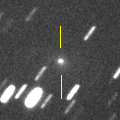
|
It brightened rapidly and became brighter than expected. Now it is 16.7 mag (Feb. 7, Toshihiko Ikemura, Hirohisa Sato). It is observable in good condition in the Northern Hemisphere. It locates somewhat low in the Southern Hemisphere.
Date(TT) R.A. (2000) Decl. Delta r Elong. m1 Best Time(A, h)
Feb. 13 3 44.23 22 25.6 1.597 1.945 94 16.4 20:27 (145, 24)
Feb. 20 3 58.04 21 57.4 1.680 1.959 90 16.5 20:17 (144, 24)
|
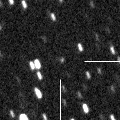
|
Now it is 16.4 mag (Jan. 17, D. Buczynski). In the Northern Hemisphere, it stays observable at 15 mag for a long time from spring to early 2022. In the Southern Hemisphere, it is not observable until the end of 2021.
Date(TT) R.A. (2000) Decl. Delta r Elong. m1 Best Time(A, h)
Feb. 13 20 4.61 48 31.8 3.807 3.522 65 16.6 3:59 (230,-31)
Feb. 20 20 8.55 50 2.0 3.756 3.488 66 16.5 4:08 (226,-26)
|
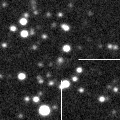
|
Now it is 16.6 mag (Nov. 9, Toshihiko Ikemura, Hirohisa Sato). It stays at 16-17 mag from 2020 to 2021. In the Northern Hemisphere, it stays observable in good condition for a long time. It is not observable in the Southern Hemisphere.
Date(TT) R.A. (2000) Decl. Delta r Elong. m1 Best Time(A, h)
Feb. 13 19 34.78 33 22.4 9.330 8.820 56 16.8 3:59 (242,-19)
Feb. 20 19 37.36 34 7.6 9.298 8.820 58 16.8 4:08 (237,-13)
|

|
Now it is 16.3 mag (Feb. 9, Toshihiko Ikemura, Hirohisa Sato). It is observable at 16.5 mag from spring in 2020 to summer in 2021.
Date(TT) R.A. (2000) Decl. Delta r Elong. m1 Best Time(A, h)
Feb. 13 17 51.83 -10 31.4 5.161 4.701 57 16.8 3:59 (264, 26)
Feb. 20 17 52.22 -10 54.7 5.061 4.711 63 16.8 4:08 (259, 34)
|

|
Now it is 17.0 mag (Feb. 6, Toshihiko Ikemura, Hirohisa Sato). It is expected to brighten up to 13 mag in 2022. In the Southern Hemisphere, it stays observable in good condition for a long time. In the Northern Hemisphere, it stays observable until June when it brightens up to 16 mag. But it will not be observable at the high light.
Date(TT) R.A. (2000) Decl. Delta r Elong. m1 Best Time(A, h)
Feb. 13 14 6.03 -17 57.2 5.056 5.452 108 16.9 3:59 (207, 71)
Feb. 20 14 2.79 -18 28.4 4.895 5.404 116 16.8 4:04 (180, 74)
|
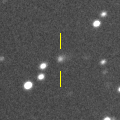
|
It brightened up to 16.1 mag in last winter (Mar. 18, Toshihiko Ikemura, Hirohisa Sato). Now it is 17.6 mag (Feb. 9, Toshihiko Ikemura, Hirohisa Sato). In 2021, it stays observable at 17 mag in good condition until summer.
Date(TT) R.A. (2000) Decl. Delta r Elong. m1 Best Time(A, h)
Feb. 13 13 14.78 -20 14.3 6.318 6.846 118 16.9 3:43 (180, 75)
Feb. 20 13 14.49 -20 2.3 6.235 6.859 125 16.8 3:15 (180, 75)
|

|
Now it is 16.8 mag (Feb. 6, Toshihiko Ikemura, Hirohisa Sato). It stays observable at 16-17 mag from 2021 to 2022.
Date(TT) R.A. (2000) Decl. Delta r Elong. m1 Best Time(A, h)
Feb. 13 14 29.76 -25 23.9 4.763 5.042 100 16.9 3:59 (237, 74)
Feb. 20 14 29.89 -24 43.9 4.629 5.023 107 16.8 4:08 (207, 79)
|

|
Now it is 16.3 mag (Oct. 17, ATLAS-MLO, Mauna Loa). It will be fading slowly.
Date(TT) R.A. (2000) Decl. Delta r Elong. m1 Best Time(A, h)
Feb. 13 18 27.46 -19 24.8 7.929 7.303 47 16.9 3:59 (278, 24)
Feb. 20 18 28.27 -19 5.6 7.852 7.325 54 17.0 4:08 (273, 31)
|
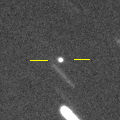
|
Now it is 16.0 mag (Feb. 7, Toshihiko Ikemura, Hirohisa Sato). It will be fading after this, and will be fainter than 18 mag in April. In the Northern Hemisphere, it stays observable in good condition for a long time after this. In the Southern Hemisphere, it will never be unobservable after this.
Date(TT) R.A. (2000) Decl. Delta r Elong. m1 Best Time(A, h)
Feb. 13 1 36.80 32 9.9 1.479 1.496 71 17.0 20:27 (130, -1)
Feb. 20 1 58.55 34 55.3 1.554 1.535 70 17.1 20:17 (132, -3)
|

|
Now it is 17.7 mag (Sept. 14, Slooh.com Chile Observatory, La Dehesa). It will brighten up to 16.5 mag in summer.
Date(TT) R.A. (2000) Decl. Delta r Elong. m1 Best Time(A, h)
Feb. 13 17 22.67 -35 57.7 5.474 5.098 62 17.3 3:59 (289, 43)
Feb. 20 17 26.77 -35 30.8 5.357 5.082 68 17.2 4:08 (286, 50)
|
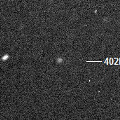
|
First return of a new periodic comet which brightened up to 16 mag from 2003 to 2004. Now it is 17.6 mag (Feb. 7, Toshihiko Ikemura, Hirohisa Sato). It will brighten up to 16 mag in next winter.
Date(TT) R.A. (2000) Decl. Delta r Elong. m1 Best Time(A, h)
Feb. 13 2 45.65 -14 0.8 4.490 4.296 72 17.3 20:27 (103, 41)
Feb. 20 2 49.99 -12 53.5 4.561 4.281 67 17.2 20:17 (102, 38)
|

|
Now it is 18.2 mag (Feb. 2, Thomas Lehmann). It is expected to brighten up to 12 mag in 2022. In the Southern Hemisphere, it stays observable in good condition for a long time. In the Northern Hemisphere, it locates extremely low until mid February, then it becomes unobservable until 2022.
Date(TT) R.A. (2000) Decl. Delta r Elong. m1 Best Time(A, h)
Feb. 13 2 42.43 -46 22.6 6.352 6.075 69 17.4 20:27 ( 58, 51)
Feb. 20 2 41.86 -45 43.1 6.356 6.026 66 17.3 20:17 ( 58, 48)
|

|
Now it is 17.3 mag (Feb. 8, Toshihiko Ikemura, Hirohisa Sato). Although it is an asteroid, it is brightening rapidly. It may brighten up to 11 mag in 2023. In the Northern Hemisphere, it stays observable in good condition for a long time. In the Southern Hemisphere, it is not observable now. It will appear in mid March, but it stays extremely low after that.
Date(TT) R.A. (2000) Decl. Delta r Elong. m1 Best Time(A, h)
Feb. 13 18 33.05 38 45.8 7.668 7.371 68 17.4 3:59 (230,-11)
Feb. 20 18 34.60 39 23.2 7.580 7.327 71 17.4 4:08 (226, -7)
|
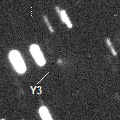
|
Now it is 17.5 mag (Jan. 17, Toshihiko Ikemura, Hirohisa Sato). It stays 17.5 mag and observable in good condition until March.
Date(TT) R.A. (2000) Decl. Delta r Elong. m1 Best Time(A, h)
Feb. 13 14 55.84 3 16.3 1.728 2.174 102 17.6 3:59 (212, 47)
Feb. 20 14 58.78 8 12.3 1.669 2.208 109 17.6 4:08 (198, 45)
|

|
Now it is 18.0 mag (Feb. 6, Toshihiko Ikemura, Hirohisa Sato). It stays 17-18 mag for a long time from 2021 to 2023.
Date(TT) R.A. (2000) Decl. Delta r Elong. m1 Best Time(A, h)
Feb. 13 11 3.88 10 22.2 4.021 4.964 160 17.6 1:33 (180, 45)
Feb. 20 11 0.71 10 41.0 3.983 4.956 168 17.6 1:02 (180, 44)
|
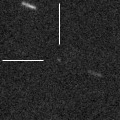
|
Now it is 17.0 mag (Feb. 7, Toshihiko Ikemura, Hirohisa Sato). Although it is an asteroid, it is brightening rapidly. It stays 17-18 mag for a long time from 2021 to 2022. In the Southern Hemisphere, it stays observable in good condition for a long time. In the Northern Hemisphere, it is observable only until May.
Date(TT) R.A. (2000) Decl. Delta r Elong. m1 Best Time(A, h)
Feb. 13 9 1.46 -6 6.2 4.778 5.703 157 17.7 23:26 (180, 61)
Feb. 20 8 54.71 -6 22.0 4.781 5.685 153 17.7 22:52 (180, 61)
|
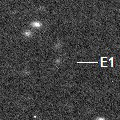
|
First return of a new periodic comet which brightened up to 16 mag in 2014. Now it is 18.6 mag (Feb. 8, Toshihiko Ikemura, Hirohisa Sato). It will brighten up to 17 mag in spring, and it will be observable in good condition.
Date(TT) R.A. (2000) Decl. Delta r Elong. m1 Best Time(A, h)
Feb. 13 13 1.80 12 21.2 1.661 2.438 132 17.9 3:30 (180, 43)
Feb. 20 13 1.55 12 30.2 1.581 2.415 138 17.7 3:03 (180, 43)
|
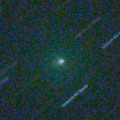
|
It brightened very rapidly up to 12.5 mag in early December (Dec. 7, Michael Jager). Now it is fading. It has already faded down to 17.5 mag (Feb. 6, Toshihiko Ikemura, Hirohisa Sato). It stays observable in excellent condition for a while.
Date(TT) R.A. (2000) Decl. Delta r Elong. m1 Best Time(A, h)
Feb. 13 4 9.05 7 36.5 1.175 1.629 97 17.8 20:27 (143, 40)
Feb. 20 4 26.27 8 4.7 1.264 1.667 94 18.3 20:17 (143, 39)
|
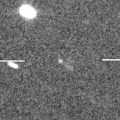
|
Now it is 17.2 mag (Feb. 8, Toshihiko Ikemura, Hirohisa Sato). It is expected to brighten up to 10 mag in 2023. In the Northern Hemisphere, it stays observable in good condition until 2023 autumn. In the Southern Hemipshere, it stays extremely low until mid July, then it becomes unobservable for a while. But it becomes observable in good condition after 2023 summer.
Date(TT) R.A. (2000) Decl. Delta r Elong. m1 Best Time(A, h)
Feb. 13 13 14.27 31 40.6 7.305 7.965 129 17.8 3:43 (180, 23)
Feb. 20 13 11.46 32 34.8 7.197 7.913 133 17.8 3:12 (180, 23)
|
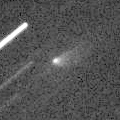
|
First return of a new periodic comet which brightened up to 17 mag in 2013. Now it is 18.0 mag (Feb. 9, Toshihiko Ikemura, Hirohisa Sato). It will be fainter than 18 mag in late February.
Date(TT) R.A. (2000) Decl. Delta r Elong. m1 Best Time(A, h)
Feb. 13 13 52.82 -3 37.0 0.522 1.306 116 17.8 3:59 (190, 58)
Feb. 20 13 51.37 -5 37.5 0.530 1.354 123 17.9 3:52 (180, 61)
|
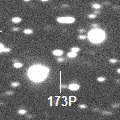
|
Now it is 16.8 mag (Feb. 8, Toshihiko Ikemura, Hirohisa Sato). It is observable at 17-18 mag for a long time from late 2019 to early 2021. It will fade out before it passes the perihelion.
Date(TT) R.A. (2000) Decl. Delta r Elong. m1 Best Time(A, h)
Feb. 13 5 18.71 20 15.2 3.887 4.411 116 17.9 20:27 (168, 34)
Feb. 20 5 19.20 20 35.3 3.978 4.403 109 18.0 20:17 (163, 33)
|

|
It stays 17-18 mag for a long time until 2026. In the Southern Hemisphere, it stays sobservable in good condition for a long time. It is not observable in the Northern Hemisphere.
Date(TT) R.A. (2000) Decl. Delta r Elong. m1 Best Time(A, h)
Feb. 13 9 28.83 -57 19.3 11.247 11.608 109 17.9 23:53 ( 0, 68)
Feb. 20 9 23.58 -57 23.7 11.203 11.591 110 17.9 23:20 ( 0, 68)
|

|
Five apparitions of this comet was confirmed in 1999, 2004, 2008, 2012 and 2016. It approached to Sun down to 0.04 a.u. on Jan. 17. It may be observed on the ground in December and February.
Date(TT) R.A. (2000) Decl. Delta r Elong. m1 Best Time(A, h)
Feb. 13 1 39.89 14 44.7 0.478 0.892 64 17.9 20:27 (118, 11)
Feb. 20 3 3.52 21 0.3 0.595 1.044 78 19.1 20:17 (134, 18)
|
|
![]()
 C/2018 N2 ( ASASSN )
C/2018 N2 ( ASASSN ) C/2020 K5 ( PanSTARRS )
C/2020 K5 ( PanSTARRS ) 117P/Helin-Roman-Alu 1
117P/Helin-Roman-Alu 1 C/2021 A7 ( NEOWISE )
C/2021 A7 ( NEOWISE ) 7P/Pons-Winnecke
7P/Pons-Winnecke C/2019 T3 ( ATLAS )
C/2019 T3 ( ATLAS ) P/2020 T3 ( PanSTARRS )
P/2020 T3 ( PanSTARRS ) 277P/LINEAR
277P/LINEAR C/2020 M5 ( ATLAS )
C/2020 M5 ( ATLAS ) C/2019 O3 ( Palomar )
C/2019 O3 ( Palomar ) C/2017 Y2 ( PanSTARRS )
C/2017 Y2 ( PanSTARRS ) C/2020 Y2 ( ATLAS )
C/2020 Y2 ( ATLAS ) C/2019 C1 ( ATLAS )
C/2019 C1 ( ATLAS ) C/2020 H6 ( ATLAS )
C/2020 H6 ( ATLAS ) C/2017 U7 ( PanSTARRS )
C/2017 U7 ( PanSTARRS ) 162P/Siding Spring
162P/Siding Spring C/2020 O2 ( Amaral )
C/2020 O2 ( Amaral ) 402P/2020 Q3 ( LINEAR )
402P/2020 Q3 ( LINEAR ) C/2020 R7 ( ATLAS )
C/2020 R7 ( ATLAS ) A/2019 U5
A/2019 U5 C/2020 Y3 ( ATLAS )
C/2020 Y3 ( ATLAS ) 99P/Kowal 1
99P/Kowal 1 A/2020 F7
A/2020 F7 413P/2020 W4 ( Larson )
413P/2020 W4 ( Larson ) 11P/Tempel-Swift-LINEAR
11P/Tempel-Swift-LINEAR C/2020 V2 ( ZTF )
C/2020 V2 ( ZTF ) 405P/2020 U1 ( Lemmon )
405P/2020 U1 ( Lemmon ) 173P/Mueller 5
173P/Mueller 5 C/2019 E3 ( ATLAS )
C/2019 E3 ( ATLAS ) 323P/SOHO
323P/SOHO![]()























































